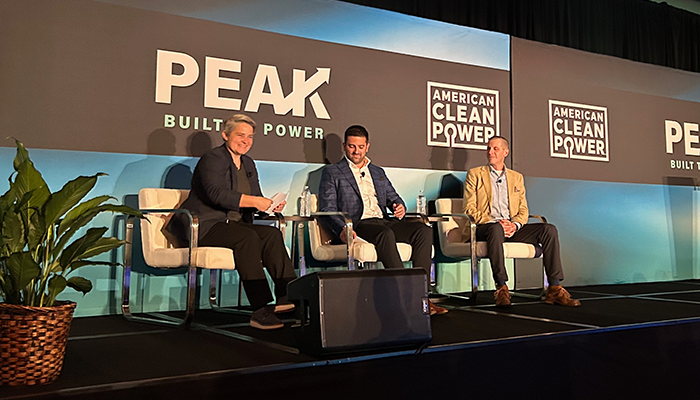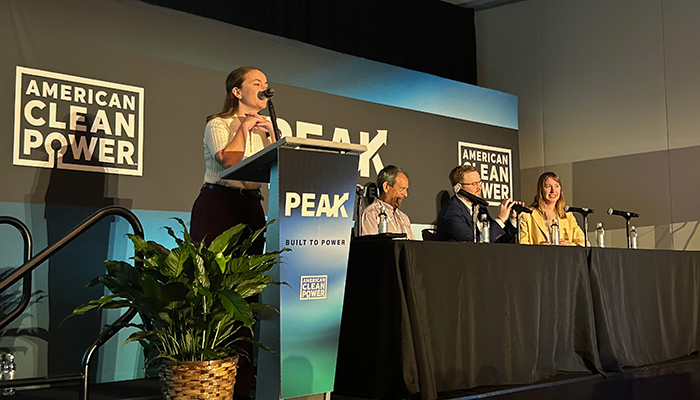Driving Clean Energy Forward: Key Insights from ACP PEAK 2025 in Austin
Last week, Austin hosted the ACP PEAK: Performance, Modeling & Assessment Conference, an annual event at which clean energy analysts come together to share their thoughts and views on the main topics that interest and inspire us. Here is a summary of the main themes and discussions that took place last week.
The opening session was led by the Program Co-Chairs. Firstly, @Emily Greeno introduced two very important members of the renewable world: @Ken Elser (Wells Fargo) and @Paul Legac (JP Morgan), who as Tax Equity providers explained exactly what they are looking for when they are assessing a potential investment in a project. This set the foundational context for the conference.

Next @Cegeon Chan introduced @Tanya Das who gave an upbeat overview of how AI might help to streamline some of the cumbersome and slow processes in the power industry.
Performance and Modeling: The Heart of the Matter
The conference emphasized data-driven modeling as the cornerstone of the ability to accurately assess the performance of projects. Sessions explored how accurate resource assessments and operational analytics reduce uncertainty and improve financial decisions and outcomes. Innovations in the areas of machine learning (ML) and digitalization were very much to the fore in the presentations and discussions. Developments that will help improve predictive maintenance practices and real-time performance tracking of renewable assets. One area that is developing rapidly is numerical site calibration which uses WRF-LES models for wind projects and strategies for integrating short-term measurement campaigns with remote sensing to enhance turbine suitability assessments. These advances are helpful for developers and operators seeking to maximize energy yield while mitigating risk and are particularly important in complex terrain.
Wind Energy: Extended Life and Repowering
Wind technology discussions focused on asset life extension and repowering strategies. With many projects approaching mid-life, operators are evaluating the suitability of their sites for repowering. By using lidars at their operational wind farms for the repowering assessments they can improve the accuracy of energy assessments particularly for farms whose hub heights are being significantly increased. Other topics included wake and blockage effects, power performance testing, and repowering economics. The message that came across from all the presenters is that renewable energy analysts are working hard to ensure that as older farms are repowered and upgraded with newer turbine technology the energy projections and benefits are accurately quantified, while the uncertainties are reduced as much as possible.
Smart Curtailment: Balancing Wind Energy Production and Bat Conservation
@Roger Rodriguez from EchoSense provided an overview of what we know about curtailment to reduce bat fatalities at wind energy facilities and how smart curtailment is being implemented to increase energy production with the same bat conservation benefit compared to the standard wind speed only or blanket curtailment. He described how analyses comparing the two common smart curtailment methods resulted in increased operational time with comparable or considerably lower bat risk when implementing real-time acoustic detection due to the ability to adapt to the fine temporal resolution of bat activity. Whereas predictive algorithms could result in overprediction or underprediction, i.e., misplaced curtailment. He envisioned how future innovation combining both methods via AI could result in further optimization of both wind energy production and bat risk reduction, which he referred to as “intelligent curtailment.”

@Devin Saywers explains the benefits of using nacelle-mounted lidar to help diagnose turbine performance problems.
Solar and Storage: Resilience Through Innovation
Solar sessions highlighted capacity testing, performance assurance, and novel modeling techniques to address uncertainty. With climate variability and extreme weather events becoming more frequent, developers are adopting advanced PV system designs and climate risk mitigation strategies. Energy storage was another hot topic, with discussions on performance management, origination strategies, and revenue forecasting for battery systems. Hybrid projects combining solar, wind, and storage were showcased as a pathway to grid stability and enhanced returns, supported by multi-tech time series modeling and GIS advancements for spatial planning.

@Haley DiGiovanni leading a panel discussing the latest innovations in solar modeling
EchoSense – Naturally Powered Bat Walk
Austin is famous for its maternity colony of Mexican Free-Tailed Bats (Tadarida brasiliensis) which occupies a large roost under the Congress Avenue Bridge. On the Wednesday evening of the conference Natural Power took a large group of conference attendees to see this colony at dusk. @Roger Rodriguez, EchoSense’s Senior Bat Biologist, provided the group with some great insights into the behavior and lifestyle of these bats culminating in the bats leaving their roost in search of food. I learned several important things that evening: firstly, young bats are called “pups”; secondly, a nursing mother has to eat her body weight of insects every day to stay healthy and to be able to feed her pup; and lastly, a long ribbon of bats flying across a shining moon on the day before Halloween is an enthralling site.

@Roger Rodriguez explains how bats echolocate and demonstrates a bat detector to the group.
Industry Outlook: Collaboration and Resilience
In these trying times for renewables in the US, one recurring theme throughout the conference was resilience—both technical and commercial. The world of renewable development has never been a straight-line march from A to B, but with ongoing supply chain disruptions and erratic policy shifts, creative thinking, flexibility and accurate modeling are needed more than ever. ACP PEAK reinforced the importance of collaboration across stakeholders—developers, operators, financiers, and technology providers—to navigate uncertainty and deliver sustainable growth. Networking sessions, including the ACP PEAK 5K run and closing jam session, fostered connections that will drive cooperation well beyond the confines of the conference.
Conclusion
ACP PEAK 2025 demonstrated the industry’s commitment to acquiring and analyzing the foundational data we need for solid assessments, along with showcasing the latest advances in technology, while also emphasizing the need for collaboration to achieve peak performance. As clean energy projects grow in size and complexity, these insights will guide strategies for optimization, resilience, and long-term success. The future of renewable energy is not just about the end goal of clean power generation, it’s also about precision, creativity, and innovation at every stage of the process.

